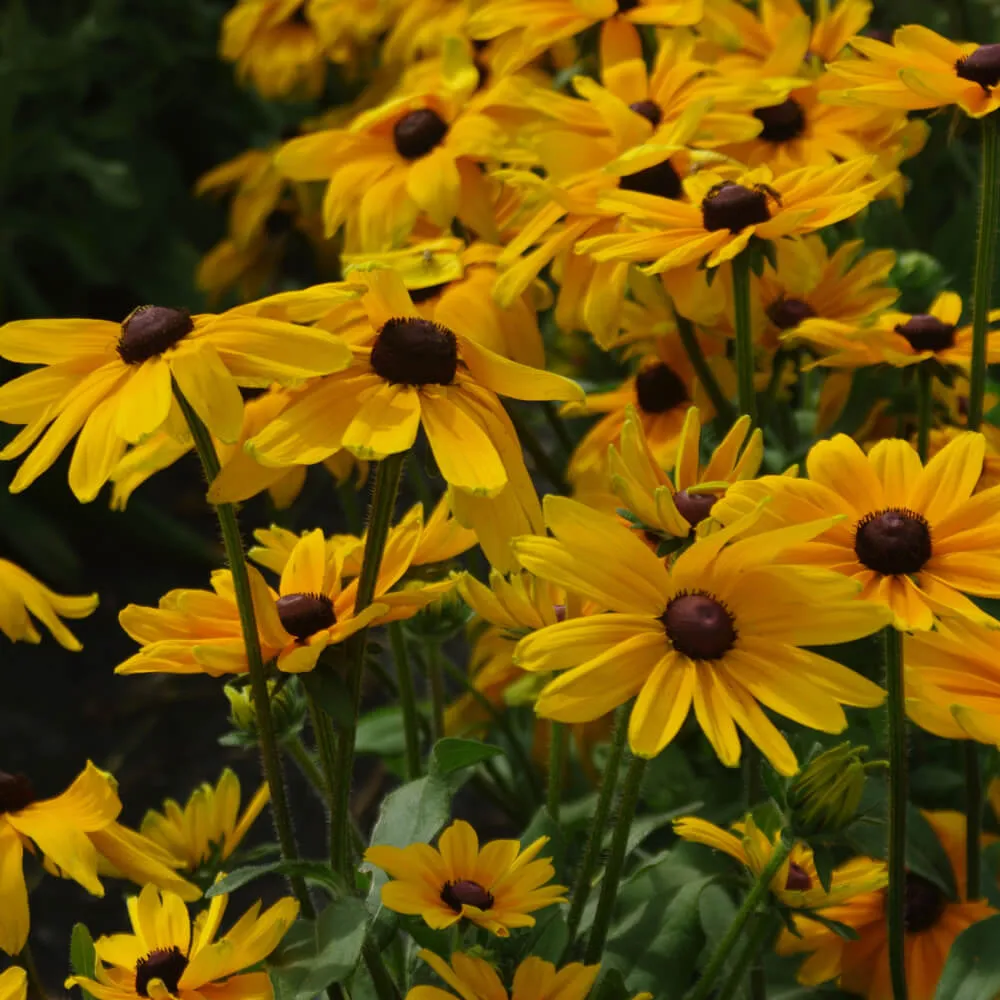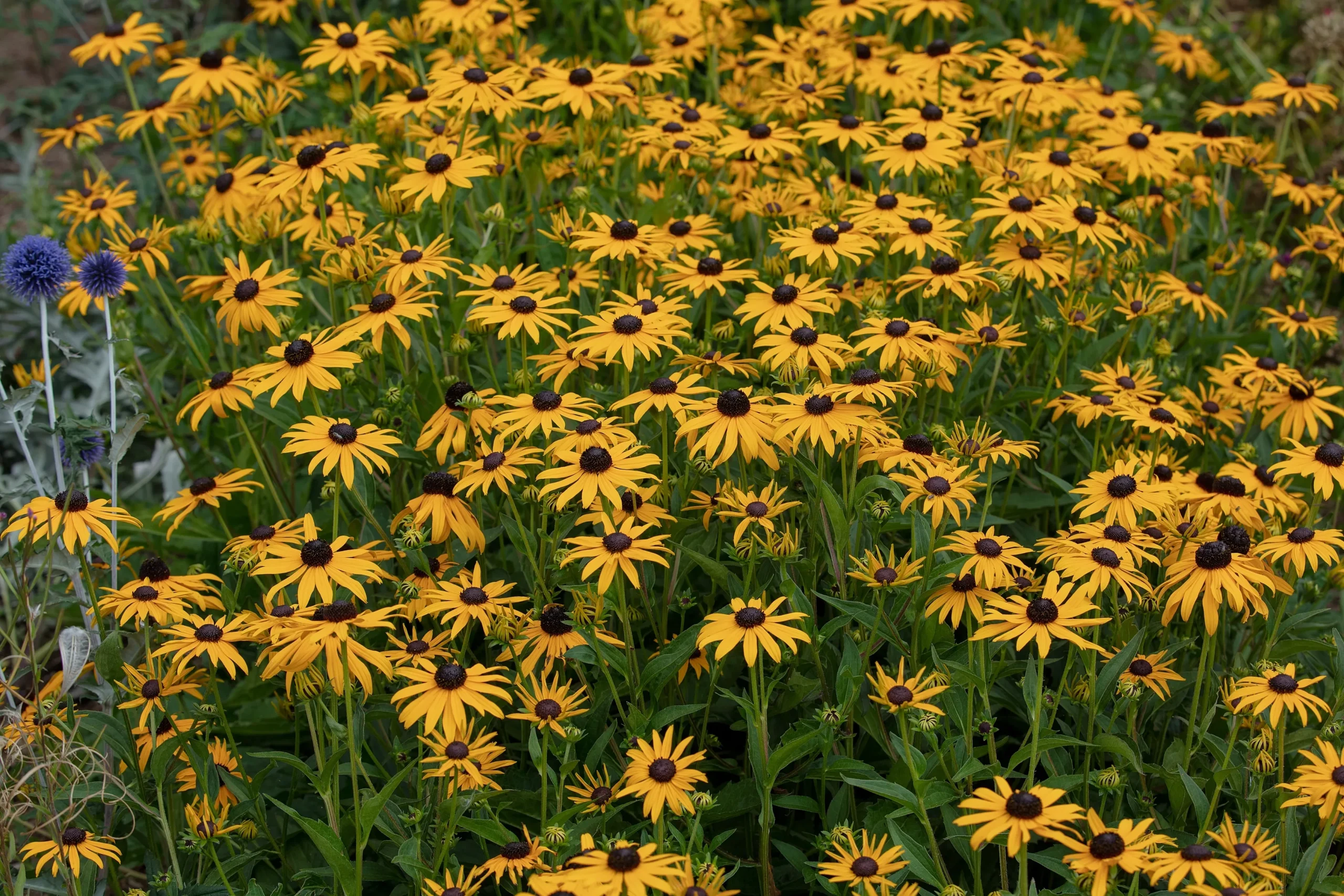Family: Coneflower
Type: Perennial
Other Common Name: Orange Coneflower, Black Eyed Susan

Rudbeckia fulgida ‘Early Bird Gold’, commonly known as Black-Eyed Susan, is a vibrant perennial that brings a burst of golden-yellow flowers to any garden. Known for its large, daisy-like flowers with a distinct dark brown center, this plant is a favorite among gardeners for its long blooming period and ease of care.
Rudbeckia fulgida ‘Early Bird Gold’ Landscaping Ideas
Plant ‘Early Bird Gold’ along walkways or garden paths. Its bright flowers create a welcoming atmosphere and guide visitors through the garden. Pair it with grasses and perennials that have contrasting foliage for a stunning visual impact.
Growing to about 2-3 feet in height with a similar spread, ‘Early Bird Gold’ is an ideal size for a wide range of garden settings. It is particularly valued for its ability to bloom earlier than other Black-Eyed Susans, often starting in early summer and continuing through fall. This hardy plant is drought tolerant once established and attracts a variety of pollinators, including butterflies and bees.
‘Early Bird Gold’ thrives in full sun and well-drained soil. It is a versatile plant that can be used in various landscaping scenarios, from mass plantings to mixed borders. Its bright flowers and robust nature make it a popular choice for adding long-lasting color to the landscape.
Hardiness Zone: 3a-4a
Deer Resistant: Yes
Pet Friendly: Yes
Moisture Preference: Average to moist
Sun Needs: Full sun
Growth Rate: Fast
Average Height (feet): 2
Average Spread (feet): 2
Average Life Span (years): 15
Form: Upright spreading
Flower Color: Yellow
Flower Eye Color: Dark brown
Flower Shape: Daisy
Bloom Season: From early summer to mid fall
Foliage Color: Green
Foliage Shape: Pointy
‘Early Bird Gold’ is perfect for creating a bright and cheerful border in any sunny garden. Its golden-yellow flowers and upright habit make it an excellent choice for adding height and color to borders and beds. Plant it in groups for a dramatic effect or use it as an accent among other perennials.
Incorporate this Black-Eyed Susan into cottage gardens or meadow-style plantings. Its naturalistic look and prolific flowering blend seamlessly with other cottage garden favorites. It also works well in wildlife gardens, attracting bees and butterflies, which adds life and movement to the garden.
Thanks to its long blooming period, ‘Early Bird Gold’ is also an excellent choice for cut flower gardens. Its vibrant flowers make beautiful bouquets and are a favorite for summer and fall floral arrangements.

In cottage gardens, 'Early Bird Gold' adds a touch of brightness with its cheerful flowers. Its informal growth habit fits perfectly into the relaxed, abundant style of these gardens.
In modern garden designs, 'Early Bird Gold' can be used to add a pop of color. Its clean lines and simple flower form complement contemporary landscaping.
'Early Bird Gold' is a great addition to pollinator gardens. Its flowers provide nectar for bees and butterflies, making it a valuable plant for supporting local ecosystems.
Plant ‘Early Bird Gold’ along walkways or garden paths. Its bright flowers create a welcoming atmosphere and guide visitors through the garden. Pair it with grasses and perennials that have contrasting foliage for a stunning visual impact.
Select our pre-made garden layouts to create a landscape that’s uniquely yours. Simple, smart, and customizable!
In spring, 'Early Bird Gold' starts to produce its foliage, preparing for the blooming season.
During summer, it's covered in vibrant yellow flowers, creating a lively and colorful display in the garden.
In the fall, 'Early Bird Gold' continues to bloom, adding warmth and color to the autumn garden.
In winter, 'Early Bird Gold' becomes dormant. While the plant may lose its leaves, the dried flower heads can provide interest in the winter landscape and food for birds.
Rudbeckia fulgida ‘Early Bird Gold’ flourishes in areas with full sun. It’s ideal for sunny borders, open meadows, or in front of taller plants in mixed beds, where its bright flowers can soak up the sun.
Full sun is crucial for 'Early Bird Gold', ensuring the most prolific blooming. It can tolerate partial shade but may produce fewer flowers in less sunlight.
This plant prefers well-drained soil and can tolerate a range of soil types, from clay to sandy soils, as long as they are not waterlogged.
Space 'Early Bird Gold' plants about 18-24 inches apart. This allows each plant enough room to grow fully and ensures good air circulation, essential for healthy growth.
The best time to plant ‘Early Bird Gold’ is in the spring after the risk of frost has passed or in the early fall, giving it time to establish before winter.
Dig a hole slightly larger than the root ball, place the plant in, fill the hole with soil, and water well. Mulching can help retain moisture and control weeds.
Water regularly, especially during dry spells, to keep the soil evenly moist. ‘Early Bird Gold’ can tolerate some drought once established.
Fertilize in early spring with a general-purpose fertilizer to encourage vigorous growth and abundant blooming.
Deadhead spent flowers to encourage more blooms. Cut back the stems to the ground in late fall or early winter after the plant goes dormant.
In spring, clean up any leftover debris from winter and apply fertilizer to kickstart growth.
Water as needed during hot, dry periods. Continue deadheading to prolong the blooming period.
Prepare for winter by reducing watering. This is a good time to divide the plant if necessary.
'Early Bird Gold' is hardy and requires minimal winter care. Mulching can provide extra protection in colder climates.
‘Early Bird Gold’ typically blooms from early summer to fall, providing a long-lasting display of color.
While no plant is completely deer-proof, ‘Early Bird Gold’ is relatively resistant to deer browsing.
Yes, ‘Early Bird Gold’ can be grown in containers, provided they have enough space and proper drainage. This makes it a versatile option for patios and balconies.
Sign up below to get exclusive deals, discounts, and new plant collections—delivered straight to your inbox! Plus, stay inspired with the latest gardening tips, landscaping trends, and DIY garden ideas. Start growing with us today!
A big thank you for subscribing to the PBN Design newsletter.
We're thrilled to have you join our community. Get ready for exciting updates, insightful content, and more delivered straight to your inbox.
Stay tuned!
Go backA big thank you for subscribing to the PBN Design newsletter.
We're thrilled to have you join our community. Get ready for exciting updates, insightful content, and more delivered straight to your inbox.
Stay tuned!
Go back